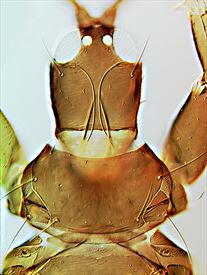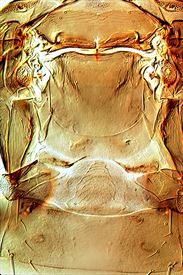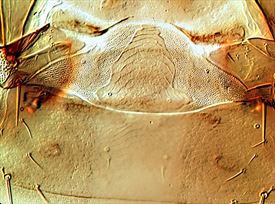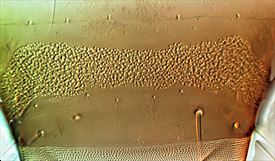
Antenna

Head & pronotum

Meso & metanotum, pelta & tergite II

Pelta & tergite II

Male sternite VIII pore plate
Distinguishing features
Female fully winged or micropterous. Body dark brown; tarsi and basal half of antennal segment III yellow; mid and hind tibiae yellowish brown at base; fore wings shaded with dark longitudinal lines in basal half, darker toward apex, clavus dark; major setae pale. Head slightly constricted at base, sculptured dorsally; compound eyes larger ventrally than dorsally; postocular setae long, acute; maxillary stylets retracted to compound eyes. Antennal segments III–VII each with a distinct pedicel, sense cones on segment III long, acute, the inner one curved, 3 on III, 4 on IV; VIII with pedicel sometimes less distinct. Pronotum with a longitudinal median apodeme; major setae long, acute, but anteroangular setae shorter; basantra absent. Mesopresternum transverse, often eroded medially; metathoracic sternopleural sutures present. Metanotum with longitudinal lateral lines in anterior half, a pair of median acute setae, and 1 or 2 pairs of shorter setae anterior to these. Fore tarsal tooth present. Fore wings with 7–13 duplicated cilia; major sub-basal seta acute, S1 and S2 variable but longer than S3. Pelta variable but usually bell-shaped, with median area usually lacking sculpture, and with at least median third of posterior margin lying on concave anterior margin of tergite II, but extreme lateral margins curving away from it; tergites II–VII each with 2 pairs of wing-retaining setae; tergite IX posteromarginal setae bluntly acute, more than half as long as tube. Female microptera with antennal sense cones smaller, less acute, and inner sense cone on III not curved; mesonotum and metanotum more transverse; wing lobe with 1 or 2 pairs of acute setae; tergites II–VII each with 2 pairs of curved wing-retaining setae.
Male microptera similar to female but sternite VIII with a transverse pore plate extending posterolaterally of spiracles; sternites III–VII with striate lines of sculpture laterally; tergite IX posteromarginal setae S2 short, stout. Large males with fore tarsal tooth larger; apex of fore tibia thickened; fore femora swollen; and pronotum elongate, with major setae longer and median apodeme more developed; head ventrally with horn-like tubercle lying between interocular setae in a few larger males.
Related species
The genus Hoplothrips comprises about 130 species worldwide, of which 7 are recorded from New Zealand. Several of these appear to be endemic to this country, but corticis is from the Northern Hemisphere and orientalis is probably from Asia. Large males of H. orientalis sometimes have a horn-like tubercle ventrally on the head. A similar structure occurs on males of H. anobii, but in that species it arises in a different position, and these two species are probably not closely related. However, orientalis is closely related to two species common in the Northern Hemisphere, H. fungi and H. karnyi, and also to H. japonicus from Asia.
Biological data
This species feeds on fungal hyphae on dead wood, as do other members of this genus.
Distribution data
This species is well-established in New Zealand (AK, CL, BP, TO / NN, BR, WD), and is widely recorded in Asia. It has also been seen from Lord Howe Island, Norfolk Island and New Caledonia.
Family name
PHLAEOTHRIPIDAE, PHLAEOTHRIPINAE
Species name
Hoplothrips orientalis (Ananthakrishnan)
Original name and synonyms
Carathrips orientalis Ananthakrishnan, 1969: 179
References
Mound LA & Walker AK (1986) Tubulifera (Insecta: Thysanoptera). Fauna of New Zealand 10: 1–140.